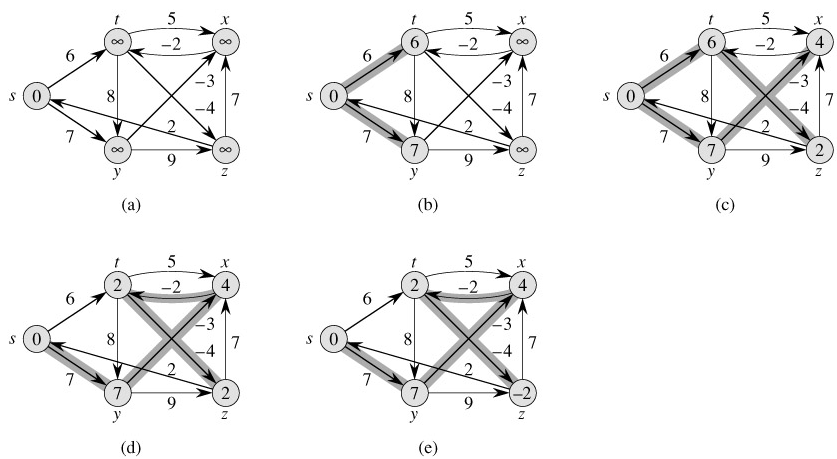SKEDSOFT
The Bellman-Ford algorithm: The Bellman-Ford algorithm solves the single-source shortest-paths problem in the general case in which edge weights may be negative. Given a weighted, directed graph G = (V, E) with source s and weight function w : E → R, the Bellman-Ford algorithm returns a boolean value indicating whether or not there is a negative-weight cycle that is reachable from the source. If there is such a cycle, the algorithm indicates that no solution exists. If there is no such cycle, the algorithm produces the shortest paths and their weights.
The algorithm uses relaxation, progressively decreasing an estimate d[v] on the weight of a shortest path from the source s to each vertex v ∈ V until it achieves the actual shortest-path weight δ(s, v). The algorithm returns TRUE if and only if the graph contains no negative-weight cycles that are reachable from the source.
BELLMAN-FORD(G, w, s) 1 INITIALIZE-SINGLE-SOURCE(G, s) 2 for i ← 1 to |V[G]| - 1 3 do for each edge (u, v) ∈ E[G] 4 do RELAX(u, v, w) 5 for each edge (u, v) ∈ E[G] 6 do if d[v] > d[u] w(u, v) 7 then return FALSE 8 return TRUE
Figure 24.4 shows the execution of the Bellman-Ford algorithm on a graph with 5 vertices. After initializing the d and π values of all vertices in line 1, the algorithm makes |V| - 1 passes over the edges of the graph. Each pass is one iteration of the for loop of lines 2-4 and consists of relaxing each edge of the graph once. Figures 24.4(b)-(e) show the state of the algorithm after each of the four passes over the edges. After making |V|- 1 passes, lines 5-8 check for a negative-weight cycle and return the appropriate boolean value. (We'll see a little later why this check works.)

The Bellman-Ford algorithm runs in time O(V E), since the initialization in line 1 takes Θ(V) time, each of the |V| - 1 passes over the edges in lines 2-4 takes Θ(E) time, and the for loop of lines 5-7 takes O(E) time.
To prove the correctness of the Bellman-Ford algorithm, we start by showing that if there are no negative-weight cycles, the algorithm computes correct shortest-path weights for all vertices reachable from the source.